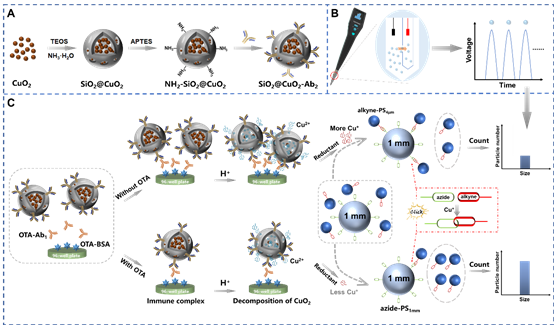Recently, the sensing and photoelectric detection technology research team of the Analysis and Test Center of the Chinese Academy of Tropical Agriculture Sciences has made important progress in the research on agro-products mycotoxins rapid detection technology. The team used a portable cytometer as a signal detection device to develop a particle counting immune sensor for rapid and sensitive detection of ochratoxin A (OTA) in agro-products, providing a new solution for portable detection of mycotoxins.
Ochratoxin A (OTA) is a harmful mycotoxin produced by Aspergillus and Penicillium, and is widely found in agricultural products such as grains, wine and coffee. Contamination of this toxin not only threatens human health, but also affects the integrity of agroecosystems. OTA can cause kidney, liver, and nervous system damage, and may even affect development and immune systems. Therefore, rapid and accurate detection of OTA is of great significance to ensure the agro-products safety and public health.
Due to their convenience and efficiency,portable cytometers have attracted much attention in scientific research and commercial fields in recent years. Based on the Kurt principle, this study proposed to use polystyrene (PS) microspheres as signal probes and combine efficient copper-catalyzed azide-alkyne cycloaddition (CuAAC) reaction as signal transduction strategy to construct a new type particle counting immunosensor to detect OTA. The team synthesize SiO₂@CuO₂nanoparticles with good dispersion and uniformity as signal transduction media by the one-pot method under room temperature. Subsequently, a 1 mm polystyrene microsphere (PS1 mm) with a large particle size and visible to the naked eye was selected as the reaction and separation carrier, and a 4 μm polystyrene microsphere (PS4 μm) was used as the signal probe. Azide groups were modified on the PS1 mm surface, and alkyne was modified on the PS4 μm. Through CuAAC reaction, a large amount of alkyne-PS4 μm was bound to a single azide-PS1 mm surface. After the reaction is completed, the azide-PS1mm combined with its alkyne-PS4μm settles rapidly due to gravity and does not require manual separation; while the unreacted alkyne-PS4μm is suspended in solution and can be directly used for detection. The entire detection process starts with the immune response. After the immune response, SiO₂@CuO₂ nanoparticles promote the CuAAC reaction, further promoting the binding of alkyne-PS4μm and azide-PS1mm. Finally, using a portable cytometer to measure the unreacted alkyne-PS4 μm quantity in the solution and the OTA concentration was determined by statistical analysis of its remaining quantity. The detection limit of this method is as low as 34 pg/mL, providing a new technical idea for the rapid and safe mycotoxins detection in agro- products.

Schematic diagram of a particle counting immune sensor for OTA detection. (A) The preparation process of SiO2@CuO2 nanomaterials. (B) Signal readout principle. (C) OTA testing process.
The research results were published in Journal “Journal of Hazardous Materials” under the title "A partial counting immunosensor for the sensitive detection of ochratoxin A via click chemistry-mediated signal amplification". Assistant researcher Chen Rui from the Analysis and Test Center of Chinese Academy of Tropical Agricultural Sciences is the first author, and Professor Chen Yiping from Dalian Polytechnic University and others are the co-corresponding authors. This research has been supported by projects such as Hainan Province key R&D plan.
Article link: https://doi.org/10.1016/j.jhazmat.2025.137381


